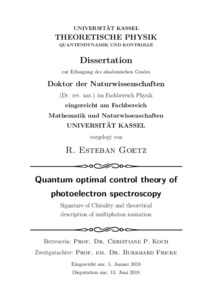| dc.date.accessioned | 2019-06-13T12:41:07Z | |
| dc.date.available | 2019-06-13T12:41:07Z | |
| dc.date.issued | 2018 | |
| dc.identifier | doi:10.17170/kobra-20190507418 | |
| dc.identifier.uri | http://hdl.handle.net/123456789/11259 | |
| dc.description | Financial support by the State Hessen Initiative for the Development of Scientific and Economic Excellence (LOEWE) within the focus project Electron Dynamic of Chiral Systems (ELCH) is gratefully acknowledged. | eng |
| dc.description.sponsorship | LOEWE | |
| dc.language.iso | eng | |
| dc.rights | Urheberrechtlich geschützt | |
| dc.rights.uri | https://rightsstatements.org/page/InC/1.0/ | |
| dc.subject | quantum dynamics | eng |
| dc.subject | coherent control | eng |
| dc.subject | quantum optimal control theory | eng |
| dc.subject | photoelectron circular dichroism | eng |
| dc.subject | parity violation | eng |
| dc.subject | photoelectron spectroscopy | eng |
| dc.subject | ultrafast photoionization | eng |
| dc.subject | coherence | eng |
| dc.subject.ddc | 530 | |
| dc.title | Quantum optimal control theory of photoelectron spectroscopy | eng |
| dc.type | Dissertation | |
| dcterms.abstract | The object of this doctoral thesis is two-fold and can be classified into two, but intrinsically related categories: (i) development of theoretical models for the simulation of electron dynamics and in parallel to this, (ii) method development of efficient numerical algorithms for ad hoc control of photoelectron and photoion-related observables. The first category primarily focuses on the development of a variety of theoretical models describing the interaction of light and matter for the extraction and control of quantum mechanical observables. In this context, this doctoral work describes how controlling specific observables, and unraveling the underlying control mechanisms, allows for a better understanding of the quantum properties that are involved. As precondition, specific and well defined optimization functionals are required. Construction of the optimization
functionals for the control of photoelectron momentum distribution and coherence in the photoion while taking into account constraints imposed over the system and ionizing field are particularly emphasized, in conjunction with analytical techniques to explain asymmetry properties in the photoelectron spectrum of chiral molecules. A new approach for the observation of electroweak parity violation effects is discussed and proposed. Furthermore, this thesis also shows how restricting the control resources allows to find novel physical mechanisms, never explored before, which arises exclusively from the wave properties of matter.
Last but not least, extensive method development of numerical algorithms were unavoidably needed over the course of this doctoral thesis. This defines the second category,
and introduces the implementation of an efficient pseudospectral numerical propagation
approach and development of a pair of new optimization techniques designed for the purpose of controlling specific properties of the photoelectron momentum distribution and coherence in the photoion. | eng |
| dcterms.accessRights | open access | |
| dcterms.creator | Goetz, Ruben Esteban | |
| dcterms.dateAccepted | 2018-06-13 | |
| dcterms.extent | V, 308 Seiten | |
| dc.contributor.corporatename | Kassel, Universität Kassel, Fachbereich Mathematik und Naturwissenschaften, Institut für Physik | ger |
| dc.contributor.referee | Koch, Christiane P. (Prof. Dr.) | |
| dc.contributor.referee | Fricke. Burkhard (Prof. Dr.) | |
| dc.relation.projectid | ELCH | |
| dc.subject.swd | Quantentheorie | ger |
| dc.subject.swd | Photoelektronenspektroskopie | ger |
| dc.subject.swd | Kontrolle | ger |
| dc.subject.swd | Parität | ger |
| dc.subject.swd | Kohärenz | ger |
| dc.title.subtitle | Signature of Chirality and theoretical description of multiphoton ionization | eng |
| dc.type.version | publishedVersion | |

